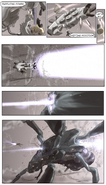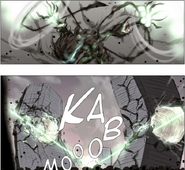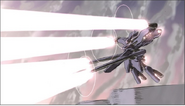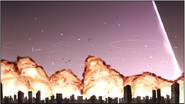
The mighty particle beam of a Blue Flower

Impact crater made by the particle beam attack of a set of G-34 Satellite Cannons
Particle Beams are charged, directed-energy beam projectiles that are generated by various sources. These are often used in military applications however particle beams can also be used for industrial and other purposes.
Humans are able to generate particle beams through machines and technology. Whereas, Beasts project particle beams using specialized organs developed through their aggressive evolution.
The more powerful a particle beam is, the more energy it expends. Thus, particle beams would require a steady and powerful source of energy, such as cores, in order for it to be produced.
Theory and Effects[]
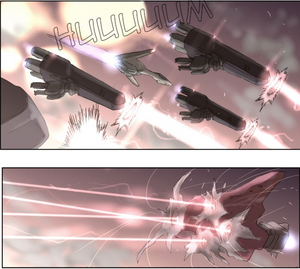
Dolores units destroying a Beast ship with their particle beam cannons
The mechanism by which a particle beam destroys a target is by focusing beam energy into a given target. As the particles of the beam collide with the target, the kinetic energy of the particles is violently imparted unto the atomic and/or molecular structure of the target - similar to a cue ball breaking apart a racked group of billiard balls. This effectively destroys the overall physical structure of the target, regardless of material composition, by disrupting it from the atomic/molecular level.
In addition to the direct kill mechanism of the beam, ancillary effects are also created: (1) Directing particle beams unto a target results in rapidly heating the impact and surrounding areas to high temperatures which can potentially cause an explosion through quick deflagration-detonation transition. Thus, a particle beam of sufficient energy can immediately destroy a target either by the sheer impact of the beam or through the following explosive reaction. (2) Within the atmosphere, a parallel cone of radiation symmetrical about the beam, would be created by the beam particles as they collide with the atoms of the air. This cone would be comprised of practically every known type of ionizing radiation (i.e. x-rays, neutrons, alpha and beta particles, etc). Other materials near the path and target of the particle beams would then be subjected to irradiation exposure which can cause damage and contamination. (3) A related tertiary effect from the beam would be the generation of an electromagnetic pulse (EMP) caused by the electric current influence of the beam. This EMP would disrupt electronic components of the target and other nearby machinery/devices. Thus, even if the particle beam missed, the ancillary effects could still trigger the kill mechanism or at least cause damage within its area of effect.
It is preferable to use a neutral-particle beam composed of Hydrogen atoms since charged particles, such as protons and electrons, have numerous issues with long distance propagation. Neutral atoms would not be susceptible to bending by the earth's magnetic field as would a charged-particle beam. Neither would the beam tend to spread due to the mutually repulsive force between charged particles. In the atmosphere, a charged-particle beam will neutralize itself by colliding with air molecules, effectively creating enough ions of the opposite charge to neutralize the beam.
Particle Beams vs Laser[]
The subatomic particles that constitute a beam have the effect of creating great penetrating power. Thus, interaction with the target is not restricted to surface effects, as it is with a laser. When impinging upon a target, a laser creates a blow-off of target material that tends to enshroud the target and shield it from the laser beam. Such problematic interaction would not exist for the particle beam with its penetrating nature. Particle beams would be quite effective in damaging internal components or might even explode a target by transferring a massive amount of energy into it (the catastrophic kill mechanism). Furthermore, there would be no realistic means of defending a target against the beam; target hardening through shielding or materials selection would be theoretically impractical or ineffective.
Countermeasures[]
Humans and Beasts discovered countermeasures resistant to the effect of particle beams through their respective research and development of barriers and in advancing material structures. Humanity created DC materials and anti-beam coating whereas Beasts on the other hand adapted armor-like traits.
Notable Particle Beams[]
- Humans
- Beasts

